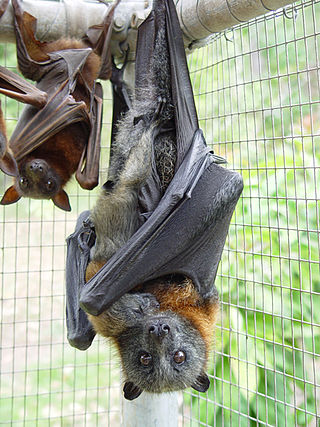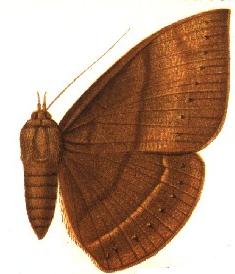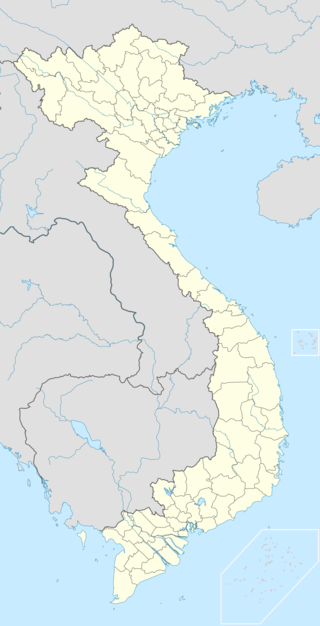
The giant golden-crowned flying fox, also known as the golden-capped fruit bat, is a species of megabat endemic to the Philippines. Since its description in 1831, three subspecies of the giant golden-crowned flying fox have been recognized, one of which is extinct. The extinct subspecies was formerly recognized as a full species, the Panay golden-crowned flying fox. Formerly, this species was placed in the genus Pteropus; while it is no longer within the genus, it has many physical similarities to Pteropus megabats. It is one of the largest bat species in the world, weighing up to 1.4 kg (3.1 lb)—only the Indian and great flying fox can weigh more. It has the longest documented forearm length of any bat species at 21 cm (8.3 in).

Pteropus is a genus of megabats which are among the largest bats in the world. They are commonly known as fruit bats or flying foxes, among other colloquial names. They live in South Asia, Southeast Asia, Australia, East Africa, and some oceanic islands in the Indian and Pacific Oceans. There are at least 60 extant species in the genus.

The Erebini are a tribe of moths in the family Erebidae.

The Indian flying fox, also known as the greater Indian fruit bat, is a species of flying fox native to the Indian subcontinent. It is one of the largest bats in the world. It is of interest as a disease vector, as it is capable of transmitting several viruses to humans. It is nocturnal and feeds mainly on ripe fruits, such as mangoes and bananas, and nectar. This species is often regarded as vermin due to its destructive tendencies towards fruit farms, but the benefits of its pollination and seed propagation often outweigh the impacts of its fruit consumption.

The Bonin flying fox, Bonin fruit bat, or in Japanese Ogasawara giant bat is a species of flying fox in the family Pteropodidae. It is endemic to four islands in Ogasawara Islands, Japan. Its natural habitat is subtropical forests. It is threatened by habitat loss.

The large flying fox, also known as the greater flying fox, Malayan flying fox, Malaysian flying fox, large fruit bat, kalang, or kalong, is a southeast Asian species of megabat in the family Pteropodidae. Despite its scientific name, it feeds exclusively on fruits, nectar, and flowers, like the other flying foxes of the genus Pteropus. It is noted for being one of the largest bats. As with nearly all other Old World fruit bats, it lacks the ability to echolocate but compensates for it with well-developed eyesight.

The Pteropodinae are a subfamily of megabats. Taxa within this subfamily are:

Andersen's flying fox is a species of flying fox in the family Pteropodidae found in south Burma and west Thailand. Although it is hunted for both food and as a pest, it is not known if this has a significant impact on the species. It has been seen roosting in tall, well-established trees in urban areas and will fly several kilometres to eat wild and cultivated fruits. The species was named after Knud Christian Andersen. It was last recorded in Thailand in 1970 and, presumably, there is still a small viable population in Myanmar.
Lygniodes is a genus of moths in the family Erebidae first described by Achille Guenée in 1852. The genus is restricted to the Asiatic tropics, east to Sulawesi and the Moluccas.

Lygniodes endoleucus is a moth of the family Erebidae. It is found in India, Thailand, Malaysia, Myanmar, Vietnam, India, China, Java, Sumatra and Sulawesi.

Lygniodes hypoleuca is a moth of the family Erebidae. It is found in Taiwan.

Lygniodes plateni is a moth of the family Erebidae. It is found on the Philippines, including Palawan.

Vampyrius vampyrus is a medium-sized species of flying frogs endemic to Vietnam. It is found in southern Vietnam, and is not known to be found in other places globally. It Is in the kingdom Animalia, phylum Chordata, and class Amphibia. Along with this, it is in the order Anura, family Rhacophoridae, and it is the only member of the genus Vampyrus. It is also known as the vampire tree frog or the vampire flying frog because of the presence of a pair of fang-like hooks in the mouth of the tadpoles.
Lygniodes ochrifera is a moth of the family Erebidae. It is found in Indonesia.
Lygniodes hypopyrrha is a moth of the family Erebidae. It is found in the Philippines (Mindanao).
Lygniodes morio is a moth of the family Erebidae. It is found in the Philippines.
Lygniodes proutae is a moth of the family Erebidae. It is found in the Philippines (Mindanao).











